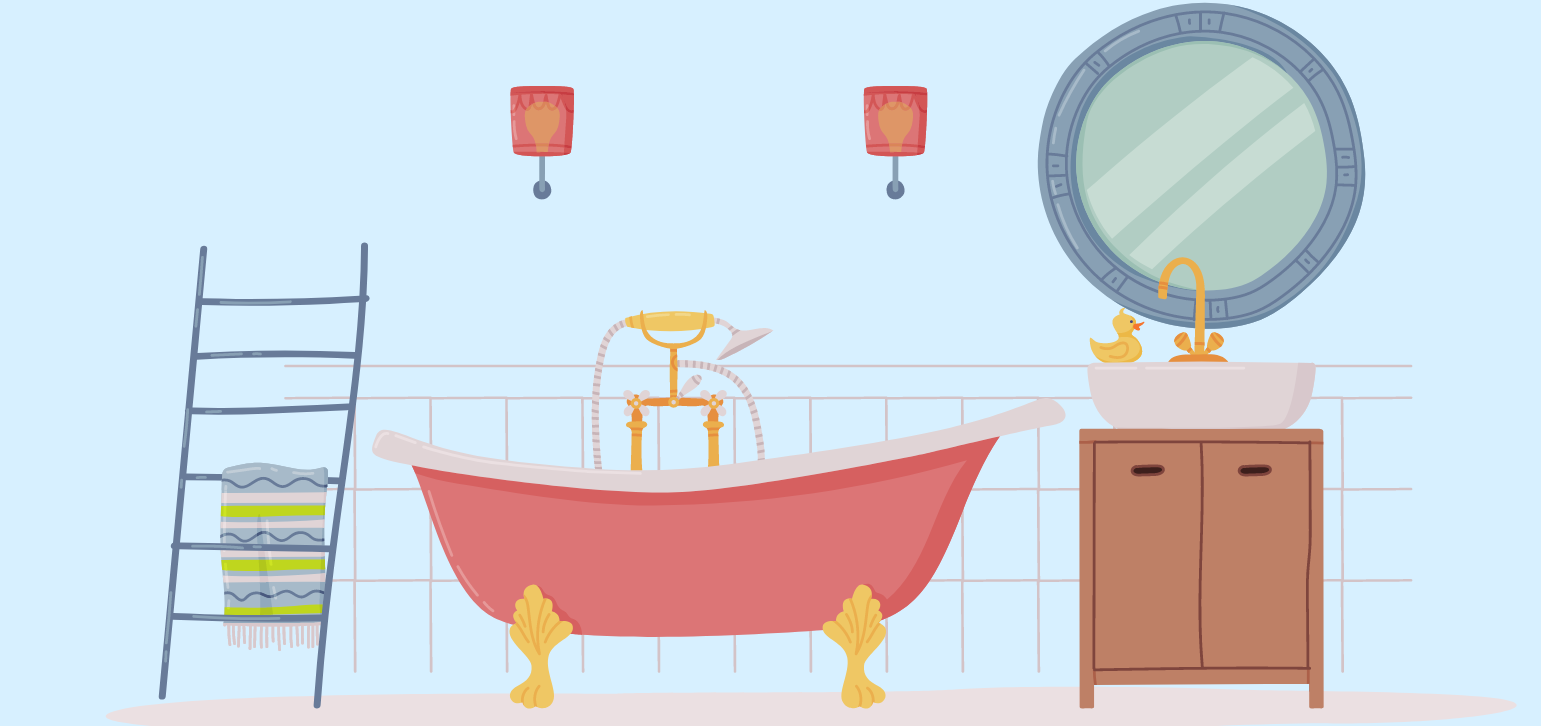
How Clean Is Your Apartment Bathtub?
Feb 12, 2024
After a stressful day at work, a hike, or a long week, you might find yourself eyeing the bathtub in your apartment. What goes through your head in this moment? Maybe you thank yourself for the idea and dive right in, or perhaps you shudder at the thought of past renters using the tub and forget it even crossed your mind. Or maybe you put in 10 more minutes of hard work with a sponge and soap before you let yourself relax and unwind among bubbles and bath salts.
What’s the right answer: Should you get on your hands and knees and scrub the tub ‘til it sparkles or should you avoid the tub altogether? We spoke to two renters and roommates, Emily Buckley and Emma Iacobucci, with differing opinions on apartment tubs, as well as an epidemiologist to get to the bottom of the controversial question: How clean is your apartment bathtub, really?
Tub of War
“If someone paid me, I’d maybe take a bath,” says Iacobucci, but typically, it’s not for her. Buckley, on the other hand, has never hesitated to use the tub in their apartment, saying, “I didn’t realize people had an issue bathing in apartment bathtubs.” Why the split?
For Iacobucci, it’s off-putting that the tub sees a lot of foot traffic: No matter how many renters come and go, the tub doesn’t get replaced for years. “It’s one of the few things that you can’t change in your apartment,” she says.
Taylor Brock-Fisher, who has an MSc in Epidemiology, resonates with Iacobucci and the anti-bath contingent. “Microbes are everywhere,” he says. “Some can cause severe diseases.”
A microbe is a microorganism or bacteria, too small to be seen with the naked eye, and whether you’re dealing with the bathtub or the doorknob, they are often lying in wait. Although they’re unlikely to actually make you sick, previous renters could have been spreading those microbes.
But with bathtubs specifically, he says, mold or fungal colonies are a concern. Since the bathroom is a site of high heat and moisture, it can become quite humid — and if your bathroom lacks proper ventilation, mold spores could be on the way. If you see black growth or lines, especially where the tub meets the wall, that mold has already arrived.
Brock-Fisher says that anti-bathtub users are also likely hesitant because of other hygienic unknowns: “I think just like in using any shared space, you always have a bit of concern about what the person using it before you may have been doing and how long it has gone between cleanings,” he says.
When it comes to the apartment bathtub question, it’s worth taking into account the microbial and hygienic factors — you don’t want to end up sick or with an infection, especially if you know your immune system is on the weaker side. However, this isn’t something Buckley worries about in her controlled bathroom environment — because she only shares the apartment with one other person. She feels a level of comfort that a person with a larger group of random roommates, for example, might not feel.
Plus, she knows when it’s best to avoid a soak. If she has any open cuts or sees rust, a stubborn and mysterious stain, or a broken piece of the tub that would risk getting a superficial injury, she avoids it. “That would be the line,” says Buckley.
Love The Digs, Dig The Tub?
So, if foot traffic is the issue, would the tub feel safer in a home you owned rather than rented? Brock-Fisher and Iacobucci think so. Plus, where Buckley and Iacobucci lives in Philly, there’s plenty of older apartments with bathtubs that have seen better days.
“When you’re a homeowner, you likely can remember the last time the bathtub and the bathroom overall were given a deep clean,” says Brock-Fisher. “You probably also have a good idea of what sort of use it has seen, and you’re probably more likely to do regular maintenance overall.”
Ultimately, the safety factor of using a bathtub in a rental will vary depending on your place.
“Personal comfort and judgment are very important,” says Brock-Fisher.
He says simply looking at and smelling your bathroom can hold your answer: “If you step in and you can smell cleaning products and the surfaces look visibly clean, you can probably feel pretty safe in using [the bathtub].”
How to Clean Your Tub
One thing you can’t ignore, whether or not you choose to soak, is the simple importance of regular cleaning.
“For long term rentals, I always start off by doing a fairly deep clean just to give me some extra comfort,” Brock-Fisher says. “An extra bit of cleanliness is never a bad thing, and keeping surfaces clean will usually give people peace of mind.”
Buckley always looks out for dust, rust, and hair in her bathroom, and she and roommate Iacobucci both use Scrubbing Bubbles bathroom cleaner to wipe it down.
If in doubt about your own cleaning routine, Brock-Fisher says the CDC offers helpful guidance for cleaning your household. They start by recommending that you use an EPA-registered disinfecting product or a stronger bleach solution.
When working with disinfectants, which will kill any viruses and bacteria on your bathtub surface, they recommend reading the label before using the product so you’re sure you’re using it safely. Don’t forget to protect your eyes, wear gloves, and maintain good ventilation (open windows or run a fan) while you’re cleaning.
One key pointer they offer is to pay attention to the “contact time” on the bottle directions. Contact time refers to the amount of time you should leave the product on the tub surface, allowing it to kill the germs. They also remind us not to mix products, use warm water to dilute the product, and wash your hands after using the product.
If still in doubt about using your apartment bathtub, take Iacobucci’s side and just say no. But don’t forget the world that awaits inside your (cleaned) tub: “You can have bubbles, you can bring a drink, you can have a podcast,” says Buckley. “It’s just a nice way to relax.”
Top cities
Atlanta Apartments
1,999 apartments starting at $600/month
Austin Apartments
4,949 apartments starting at $600/month
Baltimore Apartments
1,472 apartments starting at $500/month
Boston Apartments
3,499 apartments starting at $940/month
Charlotte Apartments
2,903 apartments starting at $450/month
Chicago Apartments
4,012 apartments starting at $450/month
Dallas Apartments
5,609 apartments starting at $604/month
Fort Worth Apartments
2,193 apartments starting at $600/month
Houston Apartments
4,504 apartments starting at $590/month
Las Vegas Apartments
1,081 apartments starting at $704/month
Los Angeles Apartments
11,535 apartments starting at $625/month
Miami Apartments
544 apartments starting at $1,000/month
Milwaukee Apartments
928 apartments starting at $465/month
New York Apartments
4,118 apartments starting at $488/month
Oakland Apartments
608 apartments starting at $885/month
Orlando Apartments
842 apartments starting at $825/month
Philadelphia Apartments
3,657 apartments starting at $550/month
Phoenix Apartments
4,153 apartments starting at $599/month
Pittsburgh Apartments
1,223 apartments starting at $600/month
Portland Apartments
2,519 apartments starting at $599/month
Raleigh Apartments
1,367 apartments starting at $750/month
San Antonio Apartments
3,925 apartments starting at $525/month
San Diego Apartments
2,960 apartments starting at $650/month
San Francisco Apartments
436 apartments starting at $675/month
San Jose Apartments
405 apartments starting at $1,300/month
Seattle Apartments
3,623 apartments starting at $450/month
Tampa Apartments
1,078 apartments starting at $800/month
Washington DC Apartments
2,878 apartments starting at $745/month


